Just when you thought there was only one type of broccoli, there are, in fact, many different types! While they all belong to the Brassica Oleracea species and have similar features, these types of broccoli can differ drastically in flavor, size and texture.
Some are even better suited for cold weather climates than others. So if you’re looking to add some variety to your broccoli dishes, here are different types to try growing at home!
The Different Types of Broccoli
Broccoli is a member of the cabbage family and is classified as an annual plant. The name broccoli comes from the Italian word “Broccolo,” which means “cabbage sprout.” Broccoli is a high-nutrient food that is rich in vitamins C, K, and A. It also contains soluble fiber and phytochemicals.
While most of us are familiar with the most common broccoli type, Calabrese, also known as green or standard broccoli, there are actually many different types of this cruciferous vegetable. Here’s a look at some of the most popular varieties:
#1 Calabrese Broccoli
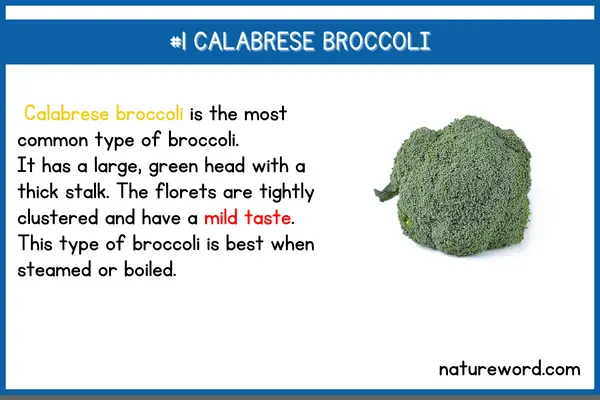
As mentioned, Calabrese broccoli is the most common type of broccoli. It has a large, green head with a thick stalk. The florets are tightly clustered and have a mild taste. This type of broccoli is best when steamed or boiled.
Unlike many other types of broccoli, Calabrese broccoli is easy to grow at home. With a little care and attention, you can enjoy fresh, homegrown Calabrese broccoli throughout the growing season.
Calabrese broccoli prefers full sun and well-drained soil. Before planting, work some organic matter into the soil to help retain moisture.
Sow seeds in early spring, spacing them about 18 inches apart. Once seedlings emerge, thin them to 12 inches apart.
For best results, water regularly and fertilize every few weeks with a balanced fertilizer. In late summer or early fall, you will begin to see small heads forming on the plants. These heads should be harvested before they reach full maturity.
Once picked, Calabrese broccoli will continue to produce side shoots that can be harvested throughout the fall season. With a little patience and effort, you can enjoy fresh Calabrese broccoli all season long!
#2 Gai Lan (Chinese Broccoli)
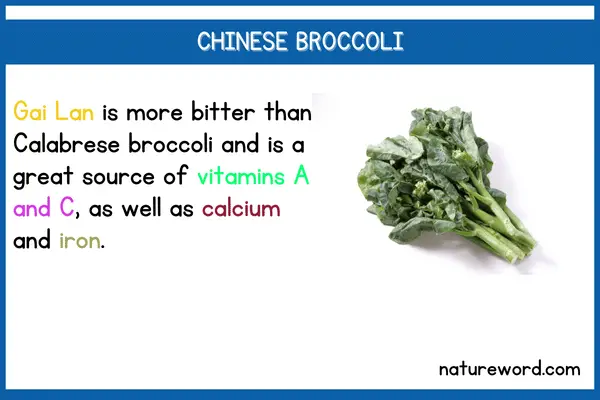
Gai Lan, commonly called Chinese broccoli, is a nutrient-rich leafy green vegetable that is popular in many Asian cuisines. Though it is often used in stir-fries, it can also be steamed, blanched, or even eaten raw.
Gai Lan is more bitter than Calabrese broccoli and is a great source of vitamins A and C, as well as calcium and iron. Furthermore, it contains compounds that may have antioxidant and anti-inflammatory effects.
If you are interested in growing Gai Lan at home, it is important to start with young plants or cuttings. Gai Lan prefers full sun but will also tolerate partial shade. The soil should be moist but well-drained and rich in organic matter.
Gai Lan can be harvested approximately 60 days after planting. To ensure a continuous supply of greens, you can sow new seedlings every 2-3 weeks.
When harvesting Gai Lan, cut the stems close to the base of the plant. With proper care, Gai Lan can provide an abundance of fresh greens for your kitchen all season long.
#3 Purple Sprouting Broccoli
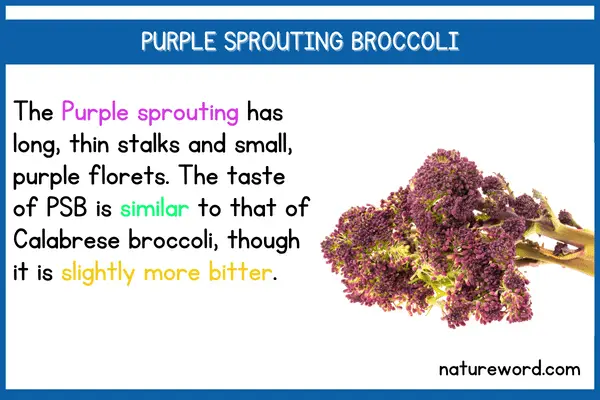
Purple sprouting broccoli, also known as PSB, is a type of broccoli that is harvested in the spring. It has long, thin stalks and small, purple florets. The taste of PSB is similar to that of Calabrese broccoli, though it is slightly more bitter.
Purple sprouting broccoli is a good source of vitamins C and K, as well as fiber and carotenoids. Some studies have shown that it may also have cancer-preventative properties.
Purple sprouting broccoli is becoming increasingly popular with home gardeners. This vibrant vegetable is not only beautiful to look at, but it also has a delicious, nutty flavor. Best of all, it is relatively easy to grow. Purple sprouting broccoli prefers cool weather and does best when planted in the fall or early spring.
It will also do well in containers, making it a great option for small spaces. When planting, be sure to choose a sunny spot with well-drained soil.
Purple sprouting broccoli will take anywhere from 60 to 90 days to mature, so be patient! Once the heads start to form, you can begin harvesting them. To enjoy purple sprouting broccoli throughout the season, make successive plantings every few weeks.
#4 Romanesco Broccoli
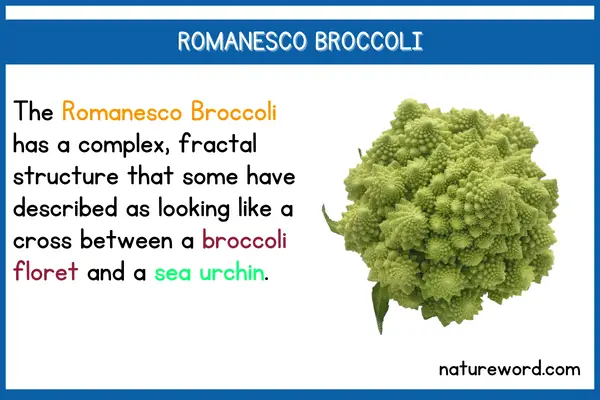
Romanesco broccoli, also known as Roman cauliflower or Romanesco cabbage, is a unique-looking vegetable that is related to both broccoli and cauliflower. It has a complex, fractal structure that some have described as looking like a cross between a broccoli floret and a sea urchin.
Romanesco broccoli can be difficult to find in grocery stores, but it is relatively easy to grow at home. The florets of Romanesco broccoli resemble miniature versions of cauliflower, but they have a distinctly nutty flavor. When cooked, the florets turn a beautiful shade of green.
This cool-weather crop should be planted in the fall or early spring. It prefers full sun but will also do well in partial shade. The soil should be moist but well-drained and rich in organic matter.
The best way to start a Romanesco broccoli plant is by starting with seedlings. Transplant the seedlings into the garden in early spring, spacing them about 18 inches apart. Provide consistent moisture, and fertilize monthly with a Nitrogen-rich fertilizer.
Harvest the broccoli when the florets are firm and bright green. Cut the stem about an inch below the floret, and remove any yellow or brown leaves. Enjoy your freshly-grown Romanesco broccoli as soon as possible for the best flavor!
#5 Belstar Broccoli
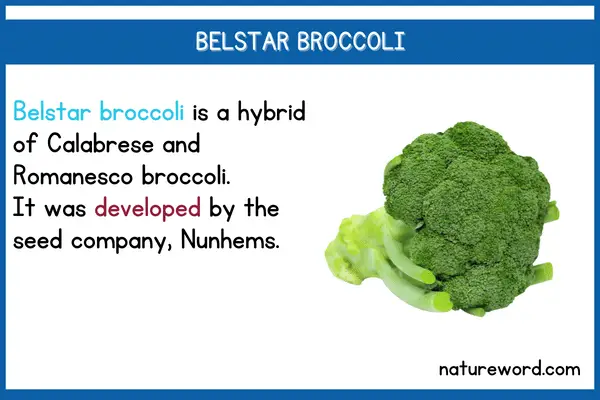
Belstar broccoli is now becoming increasingly popular in the United States, as it is prized for its flavor and nutritional value. Belstar broccoli is a hybrid of Calabrese and Romanesco broccoli. It was developed by the seed company, Nunhems.
Belstar broccoli has a compact, broccoli-like head with pointy, blue-green florets. The flavor is similar to that of Calabrese broccoli, but it is a bit sweeter and milder.
Belstar broccoli is best suited for spring or fall planting. It prefers full sun but can also tolerate some shade. The plant grows best in full sun and well-drained soil. It should be fertilized regularly, and the heads should be harvested when they are still tight and green.
#6 Tenderstem Broccoli ( aka Broccolini)
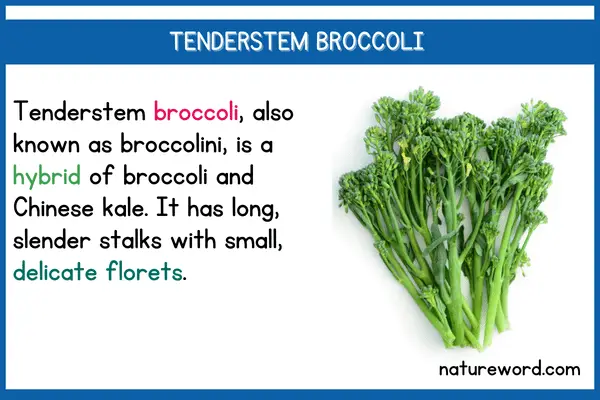
Tenderstem broccoli, also known as broccolini, is a hybrid of broccoli and Chinese kale. It has long, slender stalks with small, delicate florets. Broccolini has a slightly sweeter flavor than broccoli and is often eaten raw or lightly cooked.
This nutrient-rich vegetable is a good source of vitamins C and K, as well as carotenoids and minerals.
When choosing Tenderstem broccoli plants to grow, look for those with dark green leaves and compact clusters of florets. Avoid plants that have yellowing leaves or open flowers, as these are signs of poor-quality bulbs.
To plant Tenderstem broccoli, choose a location that receives full sun and has well-drained soil. Work some organic compost into the soil to improve its fertility, then sow the seeds about half an inch deep.
Once the seedlings have emerged, thin them out so that they are spaced about 10 inches apart. Tenderstem broccoli is ready to harvest when the stalks are 6-8 inches long, and the florets are still tightly closed. Cut the stems with a sharp knife, being careful not to damage the plant.
#7 Broccoli Raab (aka Rapini)
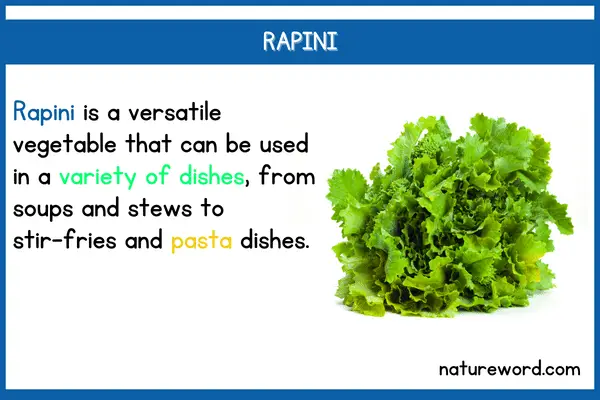
Broccoli raab, also known as rapini, is a leafy green vegetable with small flower buds that resemble broccoli. The taste of broccoli raab is similar to that of broccoli but with a slightly more bitter flavor and thinner stems. Rapini is a versatile vegetable that can be used in a variety of dishes, from soups and stews to stir-fries and pasta dishes.
When growing broccoli raab, it is important to start with young plants or seeds. Broccoli raab grows best in cool weather, so it is best to plant the seeds in early spring or late summer. The plants should be spaced about 12 inches apart so that they have enough room to grow.
Rapini prefers full sun but will also do well in partial shade. It is important to keep the soil moist but not soggy, as too much water can cause the leaves to rot.
Additionally, it is necessary to fertilize the plants every few weeks in order to promote healthy growth. With proper care, broccoli raab will be ready to harvest in about 50 days.
To Close
As you can see, there are many different types of broccoli, each with its own unique flavor and texture. If you are looking for a fun and productive way to spend your weekend, consider growing broccoli in your garden.
With so many different types of broccoli to choose from, you are sure to find one that meets your needs. And if you don’t have a garden, no problem! You can still enjoy fresh broccoli by visiting your local farmer’s market.
